This 214-acre strip mine is located in the heart of the Pine Barrens at the iconic, globally rare Frogfoot Brook. In 2010, state and Makepeace promised this site would be conservation. Instead, now it’s being strip mined.
On July 12, 2022, we started the wetlands law enforcement process with a Request for Determination (RDA) to the Conservation Commission under the Town’s Wetlands Bylaw and state Wetlands Protection Act. We claim Makepeace must get a wetlands permit for this work.
In August, 2022, after the required public hearing the Plymouth Conservation Commission voted unanimously for a “negative” decision denying our request to enforce the law. We then took the next step with an appeal to the Mass. Department of Environmental Protection (DEP). Read the appeal here. Below are Save the Pine Barrens November 22, 2022 comments to DEP. These comments are a comprehensive explanation of the ruse Makepeace is using to evade laws against sand and gravel removal and industrial mining. It urges DEP to require Makepeace to comply with the law.
We are committed to stopping this destructive project. It is based on a false pretense: that this massive earth removal operation – on of the largest single projects ever permitted — is “cranberry agriculture.” This is false: it is a stand alone mining operation. Read our comments to MassDEP below.
Who’s helping perpetuate this scam? Engineers from Beals+Thomas, Bill Madden, P.E. Makepeace’s long time cover, and Town officials. Here’s a letter where they call the strip mine the “FARM OF THE FUTURE”!
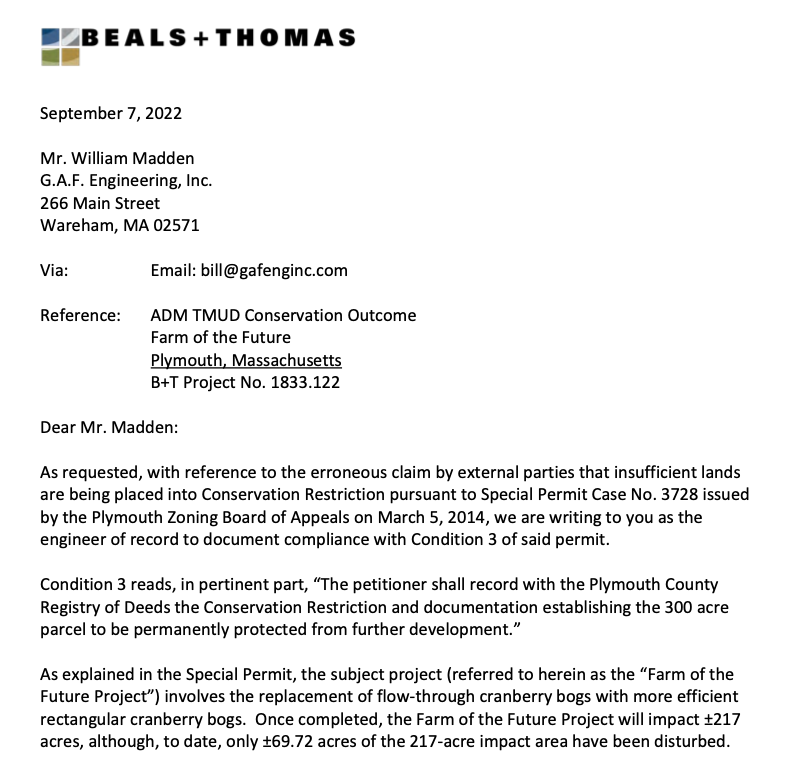
We are using the wetlands laws to protect rivers and wetlands. The mine is sandwiched between the iconic Frogfoot Brook and Wankinko River. Both have important fisheries. They flow to Buzzards Bay. They are in the heart of one of the state’s most archeologically significant areas used by Native Americans for tens of thousands of years.
Map shows 100 foot hills between the Wankinko River and Frogfoot Brook where Makepeace is mining sand and gravel.
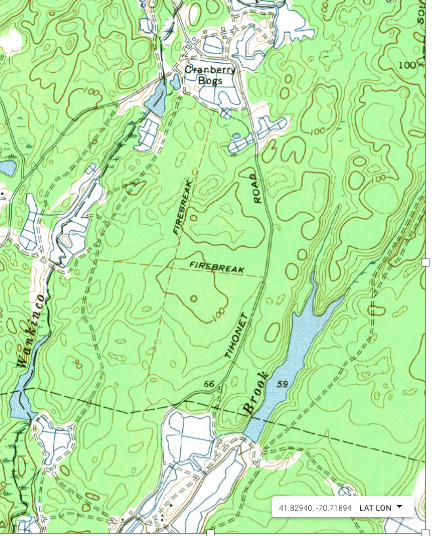
In a separate legal proceeding, we are enforcing the Plymouth earth removal zoning bylaw against Makepeace at this site. The Plymouth Zoning Board of Appeals issued a mining permit in 2014 to Makepeace. Makepeace started work but the zoning permit has expired. The Town did nothing and let the work continue. Makepeace is violating the permit conditions. The related ZBA proceeding is underway and a hearing set for December 7, 2022. Read more here.
Makepeace’s sole response to the wetlands permit issue is that in 2013 the Plymouth Conservation Commission said Makepeace did not have to get a permit. They were wrong then and are wrong now. Here is Makepeace’s letter:
Makepeace’s August 17, 2022 letter to the Commission
Map of the “cranberry bog” site with wetlands. Makepeace claims it is building cranberry bogs even though the industry has been stagnant for a decade. Still, it keeps mining sand and gravel.
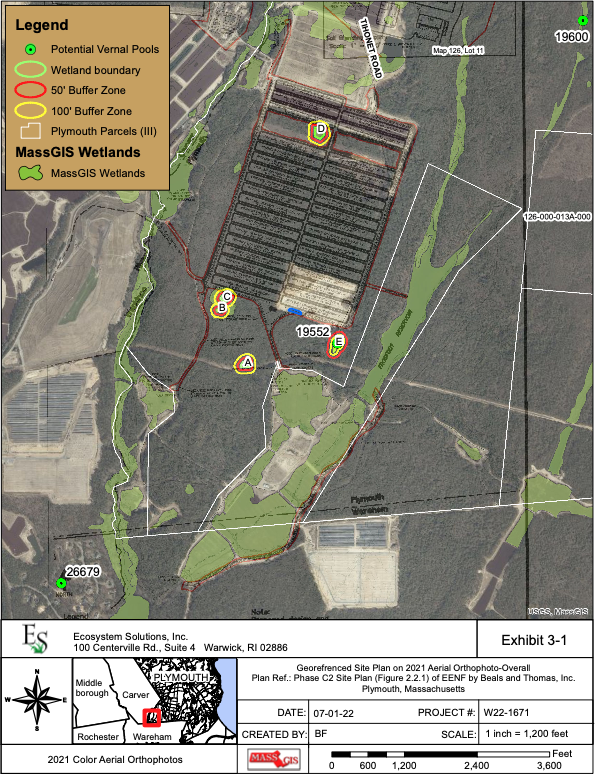
SAVE THE PINE BARRENS COMMUNITY LAND & WATER COALITION 158 CENTER HILL ROAD PLYMOUTH MA 02360
November 23, 2022
Gary J. Makuch
Wetlands and Waterways Program Bureau of Water Resources MassDEP Southeast Region
20 Riverside Drive
Lakeville MA 02347
Re: Request for Superseding Determination of Applicability PCC 22-14R
Ten Residents’ Group and Save the Pine Barrens, Inc. (“Petitioners”) AD Makepeace Cranberry Co. LLC Phase C2 Project
Plymouth
Dear Mr. Makuch,
Petitioners submit this response to the two letters, one each from Foley & Lardner LLP and GAF Engineering, Inc. to MassDEP on behalf of AD Makepeace Cranberry Co. LLC (“ADM”) on the day of the November 3, 2022 site visit and to comments by ADM’s engineer, William Madden at the site visit.
The Foley Lardner LLP November 3, 2022 Letter (“Foley Letter”)
The Foley Letter makes two points, neither of which supports ADM’s claim that MassDEP should uphold the Commission’s negative determination.
First, the Foley Letter claims Petitioners have the burden to provide “credible evidence” that the work is subject to jurisdiction under the Wetlands Protection Act and requires a notice of intent filing. The Foley Letter would have MassDEP simply ignore admissions by ADM’s own consultants, Beals+Thomas that a notice of intent is required and similarly to wholly disregard Petitioners’ maps prepared by Ecosystems Solutions.
To further their spurious claim that Petitioners have no “credible evidence” during the November 3, 2022 site visit, ADM denied Petitioners’ wetlands expert, Brandon Faneuf of Ecosystem Solutions access to the site. This prevented Mr. Faneuf from participating in the site visit to observe the wetlands ADM claims are exempt from a notice of intent. By denying Petitioners’ expert access, ADM denied the Petitioners the opportunity to verify ADM’s claims that no notice
of intent is required. This was an obvious self-serving stunt to deny DEP the benefit of Mr. Faneuf’s professional observations. The stunt is also short-sighted as Petitioners will have the right to force a professional team site visit in the run-up to an adjudicatory hearing.
The Foley Lardner letter also misses the mark as to the timing issue.
The relevant deadline for the Commission’s decision was August 23, 2022 not September 1, 2022 as ADM argues.
The GAF Engineering November 3, 2022 Letter (“GAF Letter”) and Comments of William Madden at the Site Visit
The GAF Letter states inaccurately that,
“The work described in the 2013 RDA does not address certain water delivery systems, otherwise known as water management systems, including intake structures, lift pumps and conveyance structures.” This is entirely inaccurate and misleading.
The Commission’s negative RDA, Part B, Project Description, states “Construction of 136 acres of cranberry bots [sic] along with bog roads, landing areas, drainage canals, by-pass canals and tailwater ponds.” In other words, “water management systems.” This language is taken from GAF’s Project Narrative for the RDA, dated 10/21/2013, which describes the “drainage/flowage canals”, “two tailwater recovery ponds encompassing 18+/- acres will also be constructed…” and “the ponds will be constructed by excavating two (2) down gradient cranberry bogs” and the “construction of a by-pass canal…. “ and the channel into Frogfoot Reservoir. See, ADM’s 2013 RDA application materials in Exhibit B of Attorney Crossen’s November 3, 2022, letter to MassDEP, which include the GAF November 12, 2013 “Proposed Cranberry Bog Development Plan” (9 pages) submitted to the Commission and labeled GAF Engineering (and oddly not stamped by a professional engineer).
At the November 3, 2022 site visit, Madden repeated this erroneous claim and said the 10/21/2013 RDA he filed with the Plymouth Conservation Commission was not a request for the “water systems” associated with the bog construction. To the contrary, as described above, “water systems” are clearly contained in Mr. Madden’s own 2013 RDA for ADM.
GAF’s Letter states “The RDA pertaining to these water delivery systems is addressed in a separate filing with both DEP and the Town of Plymouth.” We are unaware of any such filing and ask DEP to require ADM to provide a copy of this filing.
At the Site Visit, Madden explained that at this time ADM only has a “concept” for the water systems” and ADM will build the bogs first, then do the specific designs for the water systems. This is in direct contradiction to not only GAF’s own RDA but ADM’s Expanded Environmental Notification Form (EENF) submitted under oath to MEPA. See, Section 2.5.1 “Methodology & Sequence” that says ,
“The initial step in bog construction is to lay out all of the site components for the particular phase, including the water supply delivery system, cranberry beds and unimproved service
roadway systems and drainage canals…Earth moving activities will proceed once erosion control measures are in place.”
As Google Earth images and the GAF plans show, ADM has started work on Block 1, Bog Sections 1 through 3 at the southern end of the site. This is near the pump to Frogfoot Brook and adjacent to the drainage canal that runs on the east side of this “phase.” Earth moving started but there are no erosion control measures in place and no plans for the “water system” according to Madden. The inconsistencies in ADM’s claims belie the obvious – there is no real plan to build a bog, just a scheme to evade local prohibitions against sand mining in this area.
This is made obvious by the “Earth Removal Table” on the Title Sheet of the GAF Plans showing that Block 1 will yield 1,863,425 cubic yards of earth material of the 7,095,000 total. The by-pass canal and infrastructure – i.e. water systems – yield a much lower volume of earth at 106,000 cubic yards and 582,625 cubic yards respectively. Naturally, ADM wants to excavate Block 1 first.
Figure 1: Earth Removal Table, GAF Engineering Plans, 2013
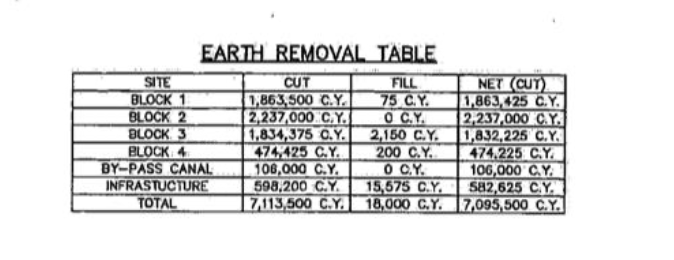
Further, the area where ADM is doing earth removal at the southern end of the site is described as “Phase 1” of the project. The EENF says the “bypass canal and soil blending facility [Read Custom Soils] will be constructed concurrent with construction of Phase 1 and 2 of the bog project.” EENF, Section 2.5.2 Phasing. Now, ADM says the bypass canal is not designed and is off into the future, not part of Phase 1 as represented to MEPA.
Finally, Google Earth images show that ADM built an agricultural canal by diverting the Wankinko River between October 2018 and 2021. This is not shown in the 2013 GAF plans
submitted with the now-expired RDA or any other known plans. MassDEP is asked to investigate this as part of the SDOA.
Figures 2 and 3: Diversion of Wankinko River
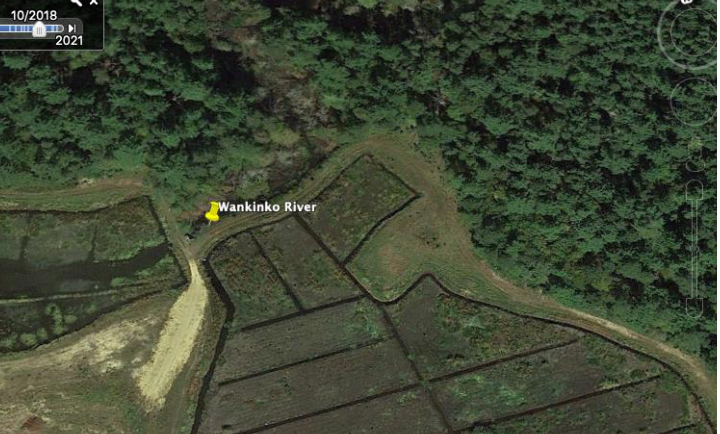

The C2 Project a/k/a “Farm of the Future” is a standalone sand and gravel mining operation designed to provide maximum revenues for ADM
ADM has rebranded the 2012 Phase C2 project as “Farm of the Future.” This is a ruse for the industrial scale sand and gravel mining operation underway at the site.
This should be no secret to MassDEP: in 2000 AD Makepeace announced the “future” of the company was not in cranberries at all.
https://cache.boston.com/globe/magazine/2000/10-15/featurestory1.shtml The Boston Globe reported,
“So, in a stunning move, [ADM’s CEO at the time] he has put a private planning team on a fast
track, working with state and local authorities to create a master plan with zoning changes that
would allow him to develop about 9,500 acres – nearly 80 percent of his unplanted holdings –
into residential and office tracts, as well as recreation areas, with some land preserved as open
space. And he is selling 45 more acres for house lots. Soon this man born with cranberry juice in
his blood, the reigning potentate of cranberrydom, will be a baron of business tracts,
condominiums, and golf courses. Cranberries could be just a tart aftertaste.”
While the CEO at the time did not foresee the lucrative future in sand and gravel mining of the
“vast deposits” on ADM’s 6,500 acres, it was clear even to him there was no future in
cranberries. Today, the current CEO and President Jame F. Kane (“Kane”) admits under oath the
company is wholly dependent on sand and gravel revenues.
ADM’s decades long claim, repeated in Carver and Plymouth time and again, is that it is necessary to level 100-foot-tall hills to build new cranberry bogs. The company’s own plans, the following facts about ADM’s operations, the manner in which it is conducting the Phase C2 project, and the cranberry industry lay bare the ruse:
ADM has reported that the aggregate acres of cranberry bogs it maintains in production has not changed substantially over the past decades.
While ADM has taken some of its older bogs out of production and replaced or refurbished some of these older bogs with much higher yielding cranberry vines – ADM still reports that the aggregate acreage of bogs it operates remains approximately 1,700 acres in total.
Notably, mature cranberry bogs were constructed on generally flat lands and often even in wetlands. Indeed, in Massachusetts many natural bogs evolved from deposits left by the glaciers more than 10,000 years ago and were not on land that was previously a hill and a lucrative source of sand and gravel.
Kane has stated, under oath, that the company regularly produces approximately 375,000 barrels of cranberries during growing seasons. See, Exhibit 1, Affidavit of James F. Kane.
ADM’s CEO also explained, under oath, that the price per barrel of cranberries has been in decline sharply over the past decade, for a few domestic and international reasons. According to the USDA the price of cranberries in Massachusetts is now approximately $37.70 per barrel.
Thus, ADM’s estimated gross revenue in 2021 for this crop is likely to be approximately $14.5 million. (For context, the USDA reports that the gross revenue for cranberry production in the entire Commonwealth of Massachusetts is only about $60 million.)
Multiple sources (academic, financial and cranberry trade related) agree that the cost to produce a cranberry is approximately $30 – $35 per barrel. Even assuming ADM has scale efficiencies smaller grower may not have, the profit margin, if any, for a barrel of cranberries, at this time, is break-even at best. This has been the case for years with no clear guidance that this will change materially anytime soon.
Nevertheless, throughout this unrelenting and substantial decline in cranberry demand, pricing and resulting profitability, ADM’s industrial-scale earth removal operations has eviscerated innumerable hills and leveled topography to below grade, for the alleged purpose of materially expanding its cranberry acreage. In fact, during this period at four sites in the Towns of Carver and Plymouth alone, ADM is mining at least 353 acres allegedly to expand its aggregate bog acreage of 1,700 by 20%. Exhibit 2, Affidavit of James Powell.
This massive extraction business – whose hallmark strategy is the deliberate leveling of massive hills of sand as ‘ground preparation’ coupled with the digging of new water reservoirs when other water sources are already readily available at or near their existing bogs on level ground which could more easily be refurbished is curiously entitled the ‘Farm of the Future’ by ADM’s consulting engineer.
And ADM further claims that to Wareham that its earth removal gimmickry is solely to extract sand for ADM’s own agricultural uses. From Wareham, ADM extracted unknown volumes of earth without permits with its engineers claiming to state and local officials that the sand would be used on its own agricultural lands. At least three sites were mined for this alleged purpose and are now industrial scale large ground mounted solar projects. When citizens in Wareham questioned the veracity of ADM’s about using the sand and gravel from that town solely for its own agricultural uses– however mathematically improbable, the CEO and President doubled down by publicly promising to account for this industrial scale sand mining in Wareham. The CEO – a veteran politician – unapologetically reneged on this promise to his host Town and its citizens. Was he too busy with the Farm of the Future or, more figuratively running for the (sand) hills?
In other documents filed in Carver and Plymouth under oath to obtain permits, ADM admits the sand and gravel is for commercial sale. ADM’s CEO and President says the company’s sand and gravel mining currently supplies about 12 concrete and asphalt manufacturing customers and “numerous other” businesses throughout New England. Exhibit 1, Kane Affidavit.
As noted, the company owns hundreds of available acres of relatively flat land which is compatible with new bog construction, and hundreds of acres of older bogs which could be efficiently refurbished with high yielding vines without knocking down and extracting 150-foot- tall hills. According to Kane’s sworn affidavit, ADM is spending up to $3.7 million annually- in payroll costs alone – on its mining operations. Over a decade, this labor cost approximates $37.2 million.
Contrast this with the cost of renovating existing bogs and replanting same with higher
producing hybrid varieties. This renovation work is estimated to cost at $40,000 to $50,000 an
acre, according to Hilary Sandler, Director of the University of Massachusetts Cranberry Station.
And in the case of ADM, this cost would necessarily be considerably lower because one of the
most expensive components of bog renovation – sand – is freely available to this sand mining
behemoth.
It is not hard to imagine that any real business, particularly a cranberry company which is
operating at razor thin margins or at a loss would invest $37 million – in labor costs alone – over
the past decade – solely for mining sand. The claim to Wareham that the sand is to be used solely
for the construction of new cranberry bogs when the same quantity of bogs could be refurbished
to produce the same projected quantity of cranberries for less than a third of that cost, and when
the cranberry business is in free fall is not credible.
A more credible and the rational explanation is that selling the mined sand to third parties is a
different and incremental revenue source sufficient to easily absorb these higher extraction costs
and to pivot away from cranberry loses to sand mining profits and lease payments for large
ground mounted solar operations on their newly stripped land. Both latter alternative businesses
are far more profitable, are in far greater demand and are far less risky than growing agricultural
crops which are subject to multiple uncontrollable weather circumstances. SolaREIT recently
announced it purchased 125 acres of solar leases from ADM
Not mentioning sand mining, CEO Kane is quoted in the SolaREIT press release.
More telling yet, despite ADM’s claims that all the sand mining is either to level the land to build bogs or to use the sand to build, maintain or renovate bogs — the company has not yet actually constructed a single cranberry bog or planted a single cranberry vine over any of the demolished 353 acres in Wareham and Plymouth. Repeat- not a single cranberry has been produced over these 353 acres of ongoing destruction. Not one. Repeat not one.
What ADM is doing while selling solar leases, is removing at least fifteen million cubic yards of sand for hypothetical new bogs in Carver and Plymouth. This quantity of sand has a market value of about $225 million – based on prices charged per ton of sand as reported by ADM’s sand mining subsidiary, Read Custom Soils. The “Farm of the Future” will generate about half of those revenues.
This estimated sand revenue – spread over the past decade – undoubtedly far outweigh the estimated cranberry profits ADM has obtained for the same period – multiple times over.
If any of these financial assumptions are false, let’s hear ADM explain how and why.
“Solar aligns with our company’s core values and respect for the land. SolaREIT was a great
partner to work with–their process is simple and efficient,” said James Kane, President and the
CEO of the A.D. Makepeace Company. “Respect for the environment guides everything we do at
the A.D. Makepeace Company and our solar installations are an important part of that.”
ADM and other “cranberry” companies exploit two legal loopholes for “agriculture” to support the Farm of the Future sand mining rouse. First, DEP should be aware that cranberry companies are invoking the G.L. c. 40A, § 3 zoning protections for “agriculture” to seek earth removal permits from towns where zoning prohibits industrial mining operations on land zoned residential and/or agricultural. By claiming the projects are “agriculture” the companies get around the ban because the zoning law protects agricultural uses due to the public benefits of actual, real farming (not concocted cranberry projects). In viewing the SDOA request, MassDEP should be aware of the ruse that is going on at the local level and not rely on unverifiable claims by cranberry growers that earth removal has the blessing of local officials as “agriculture.”
Under Massachusetts law and the earth removal Bylaws of Plymouth, Carver and Wareham, sand removed under the claim of being solely ancillary to growing cranberries must be entirely secondary to the primary business of cultivating and selling cranberries on the land that is being used for agriculture. See, Henry v. Board of Appeals of Dunstable, 418 Mass. 841 (1994); Old Colony Council-Boy Scouts of Am. v Zoning Board of Appeals of Plymouth, 31 Mass. App. Ct. 46 (1991). On the Plymouth C2 site, no cranberries were being grown when the earth removal started in 2014. Therefore, the site was not being used for “agriculture” and could not lawfully claim the Chapter 40A, Section 3 agricultural exemption to use the site for earth removal for “agricultural purpose.” Nevertheless, ADM claimed the agricultural exemption and using its political clout ADM convinced local officials to go along. ADM has derived substantial revenue for mining about 30 acres of the Plymouth site so far. The revenue derived from the small fraction of bogs it planted after the mining operation is miniscule based on market numbers. Second, as noted, ADM and others invoke the Act’s regulatory provisions for “normal improvement of land in agricultural use” to claim that the industrial mining projects are exempt from the Act’s permitting.
This solely ancillary claim of “agriculture” is contrasted sharply however by ADM’s President and CEO Kane whose sworn testimony confirms that this supposed ‘ancillary’ work necessitates the transport of sand by upwards of “60 independent truck operators”. Exhibit 1 Kane Affidavit.
And “the machines and trucks involved in the projects require fuel and repairs. If work on these projects were to cease, such expenses would not be needed. Based on past years, Makepeace estimates that this would result in the loss of millions of dollars”.
In sum, ADM has sworn under oath that its sand mining business is so massive that it has to develop a small local economy to support the extraction. Hardly ancillary.
ADM’s excavation into the groundwater violates the GAF plans and shows mining to maximum the volume of sand extraction, not build cranberry bogs.
The RDA appeal contains aerial photographs showing a pond measuring 221 feet by 47 at Block 1 on the GAF plans. The photographs show mining equipment and a propane tank on the bank of the pond. GAF’s bog construction plans call for mining above the groundwater, not in it. Typically, the mining industry uses sand washing equipment on site to wash sediment from the sand to make it more marketable.
ADM’s mining below the ground elevation appears totally inconsistent with the GAF bog construction plans, especially since the GAF Letter and Madden state that ADM is not building “water systems” at this time and only has a “concept” for them.
As noted, Block 1 is at the southern end of the site where most of the sand and gravel is located. The plans show the Block 1 hill will be leveled from 100.3 feet to 67 feet. According to the GAF cranberry bog construction plans bog excavation stops at 64.25 feet, the base of the bog. Evidence from ADM’s own groundwater monitoring well near the pond shows the excavation went at least as low as 56 feet or about eight feet below where it was supposed to stop.
If ADM is building a bog, it did not need to excavate below 64.25 feet, down to 56 feet or lower. Surely with its professed expertise in bog building and excavation, it knows how to follow its own long-time engineer’s plans by keeping to the right elevation. Instead, ADM just kept digging.
This is demonstrated as follows. The pond is near ADM Monitoring Well 1. See, Monitoring Well Table for seven wells with monthly results, November 2011 to August 2013.
The lowest reported groundwater elevation at Well 1 is 56 feet in July 2012 and the highest elevation is 58.60 feet. The ground elevation is 63.35 at Well 1.
The bottom of the proposed cranberry bog canal at 64.25 feet is about six feet above the highest reported groundwater elevation for Well 1 (58.60) and about nine feet above the lowest groundwater elevation for Well 1 (56). This means excavation into the water table as shown in the photographs has gone below the ground elevation at 63.35 and below the bottom of the proposed agricultural canal at 64.25 feet. The excavation encountered groundwater at somewhere between 58.58 feet and 56 feet based on the monitoring plans.
When this matter was brought to the attention of the Town of Plymouth Building Inspector in Spring 2022, ADM filled in the pond. A subsequent “site visit” by Environmental Partners, engineer for the Town, did not report the existence of the pond because ADM had filled in it. It is not known what was used to fill the hole.
The creation of this pond and excavating the 100 foot hill into the groundwater and creating a pond is not part of construction of a pond but a mining operation.
Cumulative impacts of ADM’s sand and gravel mining
ADM’s use of “agricultural exemptions” to conduct industrial sand and gravel mining operations throughout Southeastern Massachusetts has created a wasteland of denuded and barren landscapes. At the three mining sites in Carver allegedly for “agricultural projects”, “The clear- cutting of trees has significantly reduced evapotranspiration (ET) rates which increase groundwater recharge rates, changes groundwater flow directions, and ultimately alters the hydrological regime of wetlands (including downstream headwater streams. Affidavit of Scott Horsley, Exhibit 3 hereto. These ADM mining projects “will result in significant alterations to these recharge rates and to they hydrological regime of the wetland.” Horsley Affidavit, paragraph 26(D) and (I).
The three Carver “cranberry agriculture” sites have been significantly excavated to depths minimizing depths to groundwater…” Horsley Affidavit paragraph 23.
From about 2010 to 2016, using the claim of “squaring off the bogs” ADM conducted unpermitted sand and gravel mining at the Carverside bogs adjacent to C2, not simply “squaring them off”, but almost doubling them in size by clearing about 12 forested acres and using it for a dump, filling it in and building a cranberry bog over it. This is shown clearly on satellite images from 2010 to present. It has been reported to MassDEP for enforcement.
This included the diversion of the Wankinko River with no known permit from any federal, state or local agency. See Figures above.
ADM’s drastic alterations of topography, mining into the groundwater, denuding the land and removing trees, vegetation and sand and gravel that filters the Sole Source Aquifer is having extensive impacts on the environment in the area of the C2 project. Horsley Affidavit, Exhibit 3.
MassDEP must exercise its responsibility to the public interests of the Wetlands Protection Act and 310 CMR 10.01(2) by ending its participation in this ruse
MassDEP cannot ignore ADM’s missing “agricultural projects” or the impacts of industrial scale sand and gravel mining. MassDEP should end its participation in the pervasive schemes of sand and gravel mining operations posing as “cranberry agriculture” concocted to evade the Wetlands Protection Act, local wetland bylaws and zoning prohibitions against sand and gravel mining on land zoned residential and/or agricultural.
Irreplaceable Pine Barrens foresst, wetlands, riverfront areas, Priority Habitat for endangered, threatened and special concern species and Indigenous cultural sites have been obliterated by decades of industrial scale sand mining by AD Makepeace and others. The impacts on the Plymouth Carver Sole Source Aquifer and drinking water of 200,000 people will probably never be known. DEP must not ignore the fact that “cranberry agriculture” is all too often a cover for industrial sand mining.
Conclusion
At a minimum, ADM must cease and desist all work until:
1. ADM provides an independent third-party accounting of the volume of earth removed from the C2 and Carverside bog sites in order to ascertain the cumulative past and future cumulative impacts of the alterations in topography on wetlands, groundwater recharge rates, the Wankinko River and Frogfoot Brook.
- ADM provides a credible explanation of why it is necessary to conduct the “agricultural” excavation in Plymouth when the industry is in a downturn, and it has not built any of the agricultural projects in Carver it said it was going to construct.
- ADM shows compliance with the NPDES stormwater program for the excavation work it has already done at C2, and pays any penalties for doing the work without an NPDES permit.
- MassDEP investigates the size and scope of ADM’s excavation into the Sole Source Aquifer at the Carverside bogs and the Phase C2 sites in Plymouth.
Exhibits
1-Affidavit of James F. Kane 2-Affidavit of James Powell 3-Affidavit of Scott Horsley
cc: via email:
Michael K. Crossen, Esq. Foley Lardner
Daniel Gilmore, MassDEP Wetlands SERO
Nathaniel Stevens, Esq.
Randall Parker, Chair, Plymouth Conservation Commission Patrick Farah, for Plymouth Conservation Administrator Michelle Rowe, Plymouth Conservation Commission
Very truly yours,
Margaret E. Sheehan, Esq.
158 Center Hill Road
Plymouth MA 02360 ecolawdefenders@protonmail.com
For Save the Pine Barrens, Inc. and Ten Residents Group

[…] South Plymouth/AD Makepeace strip mine 217 acres of pristine Pine Barrens forest and Priority Habitat for Rare & Endangered Species being mined illegally by AD Maekpeace; violating wetlands laws by working with a permit; earth removal permit expired. You Tube drone video here showing mining and sand washing operation. ATTEND! August 23, 2022 Conservation Commission Public Hearing; September 7, 2022 ZBA public hearing on expired earth removal permit. […]